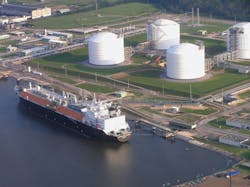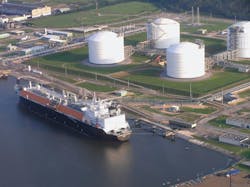Increased gas production from shale rewires global supply grid
DENVER, Colo.—"Unconventional gas is changing the dynamic within the global gas trade network," Elizabeth Spomer, senior vice-president, business development, BG Group, told attendees at the inaugural Unconventional Resources Technology Conference in Denver.
"The entrance of US exports, the extent of which remains speculative, could have quite an impact on traditional trade routes," Spomer added. The abundance of additional gas resources is quite apparent, but the transportation and processing capacity required to meet projected rises in demand is somewhat less visible.
The Sabine Pass LNG terminal in Cameron Parish, La., will expand up to four liquefaction trains by the end of 2017. "It is projected to be the largest single consumer gas terminal within the US," Spomer said. By virtue of the rise of unconventional gas in the US and Canada, she said, major demand centers are being developed.
BG Group has been active at the Lake Charles LNG terminal since 2001. In early August, the company received final approvals for its export license from the US Department of Energy. The company is expanding its unconventional resource development efforts in the US and in Canada's Montney and Horn River shale play near Prince Rupert, British Columbia.
Global demand
According to Spomer, "total demand for natural gas is around 300 bcfd. Between now and 2025, we expect demand to grow by 2.6% compounded annually," she said, adding that "when considered against the decline of existing resources, suddenly the global challenge is no longer 2.6%/year but increases to 8.8%/year."
Most of the demand is being driven by Asia—China in particular. Within the next decade, the industry will add more infrastructure to meet rapidly increasing energy demand. "This compounded annual growth represents an estimate of $2.5 trillion in investments," Spomer said.
Photo by BG Group.
The global LNG marketplace accounts for 19 import countries and 27 exporting countries. Because of large-scale unconventional gas production, "the US has the privilege of being both, which is unusual," Spomer said. Currently, the US exports LNG out of Alaska and imports via the Gulf Coast.
"Historically, LNG was used to modify stranded, low-cost gas and move it to high-value markets," Spomer explained. That paradigm has now shifted with both western Canada and the US entering the export side. For these two regions, gas is not necessarily stranded, but it is looking for a higher market.
The company projects that by 2025, LNG will represent 14% of global gas consumption.
Global supply
When looking at what supplies are available to meet this international demand, Spomer believes Canada and North American shale gas will contribute heavily.
BG Group is in the early phase of developing its LNG terminal in western Canada in the Prince Rupert area. "The challenge of Canada involves location and pipeline right-of-ways," Spomer said. Canada's western coast is flanked by two mountainous terrains and environmentally sensitive areas. "Our current location, which BG secured two years ago, is one of the few sites with coastal access," Spomer said. The LNG terminal will be supplied from operations in the prolific Montney and Horn River shales; both of these emerging plays will contribute to overall LNG demand within the next few years.
BG Group began importing LNG to Lake Charles in 2001. For the last decade, the company has held the rank as the largest importer of LNG to the US. "We've had a lot of experience bringing ships into this facility; now we will use the same Coast Guard authorization and the same 225 ships/year to export gas out of the US," Spomer said.
Generally, exports from the US will be sold to international markets equal to or greater than market prices. BG Group's Lake Charles project is being jointly developed with Energy Transfer Equity LP, and BG Group is responsible for managing the design and construction of the facility. It currently has 100% off-take at this time. According to the company, the terminal is now in the pre-FEED process. Construction is set to begin in mid-2015, with an anticipated in-service date in mid-2019.
Market growth
The majority of currently proposed LNG terminals are along the US Gulf Coast with the Everett Terminal in Boston being the only facility that has yet to apply for export authorization. "Approximately 30 bcfd of export projects are being proposed," Spomer said.
The interesting feature is what this will mean for the global market. "Mexico currently demands 2 bcfd of gas, and some projections for future demand are up to 10 bcfd by the end of the decade," Spomer said. "The US could end up exporting more gas to Mexico than any other market." This will depend on changes to Mexico's regulatory policies.
The Mexican government is actively working to encourage domestic production, but the cost structure is not in place to compete with low-cost production coming from the US in Texas' Eagle Ford shale and in the Permian basin.
"The largest single area of new demand growth is projected to be in southwest Louisiana, where exports and industrial demand will increase," Spomer added. Some projections predict incremental increases as high as 7 to 10 bcfd.
Future grid
The consensus is that unconventional export via LNG will be a global game- changer. While it creates challenges and opportunities for transportation across the existing grid structure, new large-scale demands are in flux.
"Traditional trade flows such as from the western sedimentary basins in the US to eastern Canada are already null," Spomer said, "and these are now being reviewed for conversion to oil pipelines."
Pipelines coming from the Marcellus are now moving southeast and into southwest Louisiana. Texas gas will most likely move west and south into Mexico. "It's a fascinating time to be active in this market as we see this phenomenal infrastructure being completely rewired," Spomer said.

